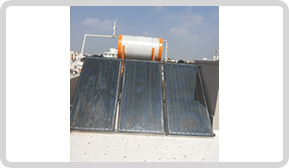
Solar Water Heater - FPC
MODELS: FPC TYPE
Flat plate collectors, developed by Hottel and Whillier in the 1950s, are the most common type.
Non Pressurised Model – Domestic (Without Heat Exchanger)
100 LPD, 200 LPD, 300 LPD, 500 LPD
Non Pressurised Model - Domestic (With Heat Exchanger)
100 LPD, 200 LPD, 300 LPD, 500 LPD
Non Pressurised & Pressurized Model - Industrial ( With Heat Exchanger & Without Heat Exchanger)
750 LPD, 1000 LPD, 1250 LPD, 1500 LPD, 2000LPD, 2500 LPD, 3000 LPD
FEATURES
They consist of

The absorber consists of a thin absorber sheet (of thermally stable polymers, aluminum, steel or copper, to which a matte black or selective coating is applied) often backed by a grid or coil of fluid tubing placed in an insulated casing with a glass or polycarbonate cover. In water heat panels, fluid is usually circulated through tubing to transfer heat from the absorber to an insulated water tank.
This may be achieved directly or through a heat exchanger. Most air heat fabricators and some water heat manufacturers have a completely flooded absorber consisting of two sheets of metal which the fluid passes between. Because the heat exchange area is greater they may be marginally more efficient than traditional absorbers.
As an alternative to metal collectors, new polymer flat plate collectors are now being produced in Europe. These may be wholly polymer, or they may include metal plates in front of freeze-tolerant water channels made of silicone rubber. Polymers, being flexible and therefore freeze-tolerant, are able to contain plain water instead of antifreeze, so that they may be plumbed directly into existing water tanks instead of needing to use heat exchangers which lower efficiency. By dispensing with a heat exchanger in these flat plate panels, temperatures need not be quite so high for the circulation system to be switched on, so such direct circulation panels, whether polymer or otherwise, can be more efficient, particularly at low light levels.
Some early selectively coated polymer collectors suffered from overheating when insulated, as stagnation temperatures can exceed the melting point of the polymer.For example, the melting point of polypropylene is 160 °C (320 °F), while the stagnation temperature of insulated thermal collectors can exceed 180 °C (356 °F) if control strategies are not used. For this reason polypropylene is not often used in glazed selectively coated solar collectors. Increasingly polymers such as high temperate silicones (which melt at over 250 °C (482 °F)) are being used. Some non polypropylene polymer based glazed solar collectors are matte black coated rather than selectively coated to reduce the stagnation temperature to 150 °C (302 °F) or less.
In areas where freezing is a possibility, freeze-tolerance (the capability to freeze repeatedly without cracking) can be delivered by the use of flexible polymers. Silicone rubber pipes have been used for this purpose in UK since 1999. Conventional metal collectors are vulnerable to damage from freezing, so if they are water filled they must be carefully plumbed so they completely drain down using gravity before freezing is expected, so that they do not crack. Many metal collectors are installed as part of a sealed heat exchanger system. Rather than having the potable water flow directly through the collectors, a mixture of water and antifreeze such as propylene glycol (which is used in the food industry) is used as a heat exchange fluid to protect against freeze damage down to a locally determined risk temperature that depends on the proportion of propylene glycol in the mixture. The use of glycol lowers the water's heat carrying capacity marginally, while the addition of an extra heat exchanger may lower system performance at low light levels.
A pool or unglazed collector is a simple form of flat-plate collector without a transparent cover. Typically polypropylene or EPDM rubber or silicone rubber is used as an absorber. Used for pool heating it can work quite well when the desired output temperature is near the ambient temperature (that is, when it is warm outside). As the ambient temperature gets cooler, these collectors become less effective.